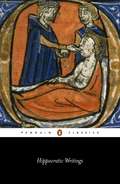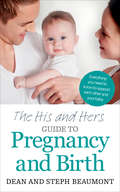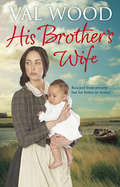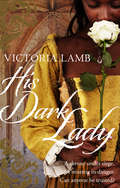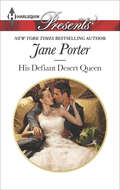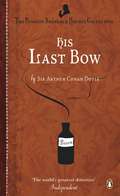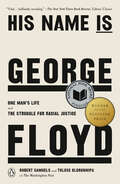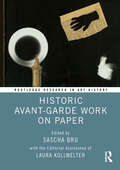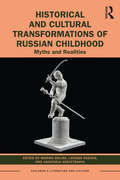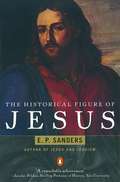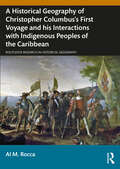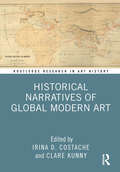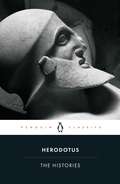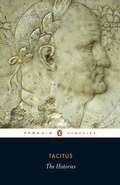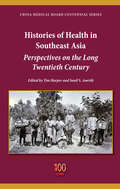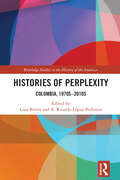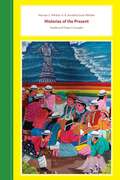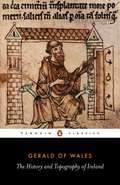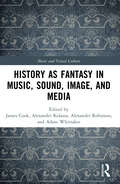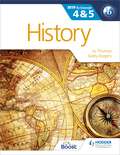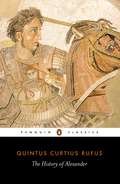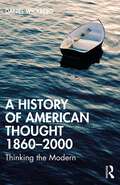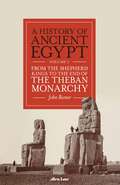- Table View
- List View
Hippocratic Writings
by HippocratesThis work is a sampling of the Hippocratic Corpus, a collection of ancient Greek medical works. At the beginning, and interspersed throughout, there are discussions on the philosophy of being a physician. There is a large section about how to treat limb fractures, and the section called The Nature of Man describes the physiological theories of the time. The book ends with a discussion of embryology and a brief anatomical description of the heart.
The His and Hers Guide to Pregnancy and Birth
by Dean Beaumont Steph BeaumontMums- and dads-to-be both want the best for their baby, but often their experiences of the journey to parenthood can be quite different. In this book, leading antenatal teachers Dean and Steph Beaumont offer a new way to prepare for your new arrival. Covering everything from first finding out you are pregnant to the early weeks with your baby, you'll find practical advice, reassurance and guidance on how you can support each other as well as your growing baby.Divided into sections with targeted information for mum and dad, addressing their concerns and questions, The His and Hers Guide to Pregnancy and Birth will support you as individuals, giving you the confidence and knowledge you need. Each chapter also includes a 'Get Together' section, which provides ideas for bonding, advice on what dad can do to help and ways to connect with and understand each other.
His Brother's Wife
by Val Wood1860. Harriet Miles is trying to take care of her seriously ill mother, and just when she thinks things couldn’t get any worse she is fired from her job at the hostelry. The last thing she expects after her mother dies is a marriage proposal from a man she barely knows, but her only alternative is the workhouse. And so begins her new life with Noah Tuke. But instead of marital bliss, Harriet finds herself in the cramped farmhouse which Noah calls home, and in this overcrowded and angry household she meets with hostility and bitterness. The only person who offers her friendship is Noah’s brother, Fletcher. Gradually she learns the true reasons behind Noah’s desire to marry her – and realises that the only person she finds real companionship with is the person she can’t possibly be with . . .If you enjoy books by Katie Flynn and Dilly Court, you'll love Val's heartwarming stories of triumph over adversity.
His Dark Lady (Shakespeare’s Mistress #2)
by Victoria LambLondon, 1583.When young, aspiring playwright William Shakespeare encounters Lucy Morgan, one of Queen Elizabeth I’s ladies-in-waiting, the two fall passionately in love. He declares Lucy the inspiration for his work, but what secret is Will hiding from his muse?Meanwhile, Lucy has her own secret – and one that could destroy her world if exposed. No longer the chaste maid so valued by the Virgin Queen, she also bore witness to the clandestine wedding of Lettice Knollys and Robert Dudley, a match forbidden by the monarch. England is in peril. Queen Elizabeth’s health is deteriorating, her throne under siege from Catholic plotters and threats of war with Spain. Faced with deciding the fate of her long-term prisoner, Mary, Queen of Scots, she needs a trusted circle of advisors around her now more than ever. But who can she turn to when those closest to her have proved disloyal? And how secure is Lucy’s position at court, now that she has learned the dangerous art of keeping secrets?
His Day: हिज डे
by Swati Chandorkarसमाजातील उपेक्षित घटक असणारे तृतीय पंथीय अर्थात हिजडे यांची ही कहाणी. त्यांचेही निरनिराळे प्रकार असतात. कोणी जन्मत:च स्त्री किंवा पुरुषाऐवजी तृतीय पंथी किंवा हिजडा असतो. देहाची जाण/समज आल्यावर कोणी स्त्री आपण पुरुष व्हावे म्हणून तर कोणी पुरुष आपण स्त्री व्हावे म्हणून निसर्गाविरुद्ध जाऊन वाटेल तो त्रास, वेदना सोसायला तयार होतात. एखाद्या स्त्रीला स्त्रीदेहाचे तर एखाद्या पुरुषाला पुरुषदेहाचेच आकर्षण वाटते; अशांना लेस्बियन म्हणतात. दैनंदिन जीवनासाठी त्यांना भीक मागणे, शुभ प्रसंगी बधाईला जाणे किंवा शरीरविक्रय असे मार्ग पत्करावे लागतात. वेगळे जीवन वाट्याला आल्याने आणि समाजाकडून बहुधा तुच्छता तसेच हेटाळणीची वागणूक मिळाल्यामुळे हे सगळे एका छताखाली म्हणजेच एक वस्ती करून राहतात. यांनाही गुरू असतो/असते. सर्वांना आपली कमाई गुरुकडे जमा करावी लागते; त्या बदल्यात गुरू त्यांचे जेवण-खाण, कपडालत्ता, आजारपण यासाठी खर्च करतो/करते. अर्थात गुरू म्हणेल ती पूर्व दिशा! याच चाकोरीतून चेला पुढे गुरू होतो. यांचीही घराणी असतात आणि प्रत्येक घराण्याचा नायक असतो. हिजडा तरुण असताना जगण्यासाठी त्याला करावी लागणारी धडपड, तडजोड, वेदना यांना अंत नाही. आजार आणि म्हातारपण यांचा सामना करण्यासाठी मानसिक बळ मिळवणं हे मोठं आव्हान त्यांच्यासमोर आहे आणि तरीही हा तृतीय पंथ ताठ आहे. एकूण हे त्यांचं आयुष्य आहे, जे त्यांनी ‘असं आयुष्य हवं’ म्हणून न मागितलेलं आणि तरीही नशिबी आलेलं. त्यांनाही चांगलं आयुष्य हवं आहे आणि या चांगल्या आयुष्यासाठी त्यांचं एकच मागणं आहे – ‘आम्हाला माणूस म्हणून जगू द्या...’
His Defiant Desert Queen (The Disgraced Copelands #2)
by Jane PorterThe New York Times–bestselling author’s “desert romance is all heat and passion, complete with a hidden hedonistic honeymoon getaway” (RT Book Reviews, 4 1/2 Stars—Top Pick).When Sheikh Mikael catches notorious model Jemma Copeland flaunting Saidia’s laws—and her body—in his desert, he knows one thing: revenge against his family’s destruction is within his reach! To achieve it he makes Jemma an offer: imprisonment or marriage.With her life shattered by the scandal that rocked her family, Jemma needed that modeling job. She didn’t know that she was breaking the law! But Mikael’s outrageous proposal pushes her beyond shock . . . to utter fury. If he expects her to be a meek, pliable bride, this arrogant sheikh has another think coming!
His Last Bow: Some Reminiscences of Sherlock Holmes
by Arthur Conan Doyle'We must fall back upon the old axiom that when all other contingencies fail, whatever remains, however improbable, must be the truth.'Sherlock Holmes's fearless chronicler Dr Watson once again opens his notebooks to bring to light eight further tales of some of the strangest and most fascinating cases to come before the enquiring mind of London's most famous detective.These mysteries involve the disappearance of secret plans as well as of a lady of noble standing; the curious circumstances of Wisteria Lodge and of the Devil's Foot; as well as the story His Last Bow, the last outing of Holmes and Watson on the eve of the First World War.
His Name Is George Floyd (Pulitzer Prize Winner): One Man's Life and the Struggle for Racial Justice
by Robert Samuels Toluse OlorunnipaFINALIST FOR THE NATIONAL BOOK AWARD AND LOS ANGELES TIMES BOOK PRIZE; SHORT-LISTED FOR THE J. ANTHONY LUKAS PRIZE; A BCALA 2023 HONOR NONFICTION AWARD WINNER. A landmark biography by two prizewinning Washington Post reporters that reveals how systemic racism shaped George Floyd's life and legacy—from his family&’s roots in the tobacco fields of North Carolina, to ongoing inequality in housing, education, health care, criminal justice, and policing—telling the story of how one man&’s tragic experience brought about a global movement for change.&“It is a testament to the power of His Name Is George Floyd that the book&’s most vital moments come not after Floyd&’s death, but in its intimate, unvarnished and scrupulous account of his life . . . Impressive.&” —New York Times Book Review (Editors' Choice)&“Since we know George Floyd&’s death with tragic clarity, we must know Floyd&’s America—and life—with tragic clarity. Essential for our times.&” —Ibram X. Kendi, author of How to Be an Antiracist &“A much-needed portrait of the life, times, and martyrdom of George Floyd, a chronicle of the racial awakening sparked by his brutal and untimely death, and an essential work of history I hope everyone will read.&” —Henry Louis Gates, Jr., author of The Black Church: This Is Our Story, This Is Our SongThe events of that day are now tragically familiar: on May 25, 2020, George Floyd became the latest Black person to die at the hands of the police, murdered outside of a Minneapolis convenience store by white officer Derek Chauvin. The video recording of his death set off a series of protests in the United States and around the world, awakening millions to the dire need for reimagining this country&’s broken systems of policing. But behind a face that would be graffitied onto countless murals, and a name that has become synonymous with civil rights, there is the reality of one man&’s stolen life: a life beset by suffocating systemic pressures that ultimately proved inescapable. This biography of George Floyd shows the athletic young boy raised in the projects of Houston&’s Third Ward who would become a father, a partner, a friend, and a man constantly in search of a better life. In retracing Floyd&’s story, Washington Post reporters Robert Samuels and Toluse Olorunnipa bring to light the determination Floyd carried as he faced the relentless struggle to survive as a Black man in America. Placing his narrative within the larger context of America&’s deeply troubled history of institutional racism, His Name Is George Floyd examines the Floyd family&’s roots in slavery and sharecropping, the segregation of his Houston schools, the overpolicing of his communities, the devastating snares of the prison system, and his attempts to break free from drug dependence—putting today's inequality into uniquely human terms. Drawing upon hundreds of interviews and extensive original reporting, Samuels and Olorunnipa offer a poignant and moving exploration of George Floyd&’s America, revealing how a man who simply wanted to breathe ended up touching the world.
Historic Avant-Garde Work on Paper (Routledge Research in Art History)
by Sascha Bru Laura KollwelterThis book examines the many functions of paper in the fine art and aesthetics of the early twentieth-century modernist or historic avant-garde (Expressionism, Cubism, Futurism, Dadaism, Surrealism, Constructivism and many more).With its many collages and photomontages, the historic avant-garde is generally considered to have transformed paper from a mere support into an artistic medium and to have assisted in art on paper gaining a firm autonomy. Bringing together an international team of scholars, this book shows that the story of paper in the avant-garde has thereby hardly been told. The first section looks at a selection of canonized individual avant-gardists’ work on paper to demonstrate that the material and formal analysis of paper in the avant-garde’s artistic production still holds much in store. In the second section, chapters zoom in on forms and formats of collective artistic production that deployed paper to move around reproductions of fine art works, to facilitate the dialogue between avant-gardists, to better promote their work among patrons, and to make their work available to a wider audience. Chapters in the third section lay bare how certain groups within the avant-garde began to massively create monochrome works, because these could be easily reproduced when transferred to, or reproduced as, linocuts. In the last section of the book, chapters explore how the avant-garde’s attentiveness to paper almost always also implied a critique of the ways in which paper, and all that it stood for, was treated and labored in European culture and society more broadly.The book will be of interest to scholars working in art history, modernism, and design.
Historical and Cultural Transformations of Russian Childhood: Myths and Realities (Children's Literature and Culture)
by Marina Balina Larissa Rudova Anastasia KostetskayaHistorical and Cultural Transformations of Russian Childhood is a collection of multidisciplinary scholarly essays on childhood experience. The volume offers new critical approaches to Russian and Soviet childhood at the intersection of philosophy, literary criticism, film/visual studies, and history. Pedagogical ideas and practices, and the ideological and political underpinnings of the experience of growing up in pre-revolutionary Russia, the Soviet Union, and Putin’s contemporary Russia are central venues of analysis. Toward the goal of constructing the "multimedial childhood text," the contributors tackle issues of happiness and trauma associated with childhood and foreground its fluidity and instability in the Russian context. The volume further examines practices of reading childhood: as nostalgic text, documentary evidence, and historic mythology. Considering Russian childhood as historical documentation or fictional narrative, as an object of material culture, and as embodied in different media (periodicals, visual culture, and cinema), the volume intends to both problematize but also elucidate the relationship between childhood, history, and various modes of narrativity.
The Historical Figure of Jesus
by E. SandersA biography of the historical figure of Jesus. The book studies the relationship between Judaism and Christianity, distinguishing the certain from the improbable, and assessing the historical and religious context of Christ's time. The spread of Christianity is also discussed.
A Historical Geography of Christopher Columbus’s First Voyage and his Interactions with Indigenous Peoples of the Caribbean (Routledge Research in Historical Geography)
by Al M. RoccaThis book offers a unique account of Christopher Columbus’s first voyage, the most consequential voyage in world history. It provides a detailed day-by-day account of the explorer’s travels and activities, richly illustrated with thematic maps.This work expands our understanding of Columbus’s first voyage by mapping his sea and land experiences, offering both a historical and geographical exploration of his first voyage. Traveling chronologically through events, the reader builds a spatial insight into Columbus’s perspectives that confused and confirmed his pre-existing notions of Asia and the Indies, driving him onward in search of new geographic evidence. Drawing from a diverse range of primary and secondary historical resources, this book is beautifully adorned with illustrations that facilitate an in-depth exploration of the connections between the places Columbus encountered and his subsequent social interactions with Indigenous people. This methodology allows the reader to better understand Columbus’s actions as he analyzes new geographic realities with pre-existing notions of the “Indies.” Attention is given to Columbian primary sources which analyze how those materials have been used to create a narrative by historians. Readers will learn about the social and political structures of the Lucayan, Taíno, and Carib peoples, achieving a deeper understanding of those pre-Columbian cultures at the time of contact.The book will appeal to students and researchers in the disciplines of history, geography, and anthropology, and the general reader interested in Colombus.
Historical Narratives of Global Modern Art (Routledge Research in Art History)
by Irina D. Costache Clare KunnyDiversifying the current art historical scholarship, this edited volume presents the untold story of modern art by exposing global voices and perspectives excluded from the privileged and uncontested narrative of “isms.” This volume tells a worldwide story of art with expanded historical narratives of modernism. The chapters reflect on a wide range of issues, topics, and themes that have been marginalized or outright excluded from the canon of modern art. The goal of this book is to be a starting point for understanding modern art as a broad and inclusive field of study. The topics examine diverse formal expressions, innovative conceptual approaches, and various media used by artists around the world and forcefully acknowledge the connections between art, historical circumstances, political environments, and social issues such as gender, race, and social justice. The book will be of interest to scholars working in art history, imperial and colonial history, modernism, and globalization.
The Histories
by Herodotus'The first example of non-fiction, the text that underlies the entire discipline of history ... it is above all a treasure trove' Tom HollandOne of the masterpieces of classical literature, The Histories describes how a small and quarrelsome band of Greek city states united to repel the might of the Persian empire. But while this epic struggle forms the core of his work, Herodotus' natural curiosity frequently gives rise to colourful digressions - a description of the natural wonders of Egypt; tales of lake-dwellers, dog-headed men and gold-digging ants. With its kaleidoscopic blend of fact and legend, The Histories offers a compelling Greek view of the world in the fifth century BC, in Aubrey de Sélincourt's elegant and celebrated translation.Translated by AUBREY DE SÉLINCOURT Revised with an Introduction and notes by JOHN MARINCOLA
The Histories
by TacitusIn AD68 Nero's suicide marked the end of the first dynasty of imperial Rome. The following year was one of drama and danger, though not of chaos.In the surviving books of his Histories the barrister-historian Tacitus, writing some thirty years after the events he describes, gives us a detailed account based on excellent authorities. In the 'long but single year' of revolution four emperors emerge in succession: Galba, Otho, Vitellius and Vespasian - who established the Flavian dynasty.Rhiannon Ash stays true to the spirit of Wellesley's prose whilst making the translation more accessible to modern readers.
Histories of Health in Southeast Asia: Perspectives on the Long Twentieth Century (China Medical Board Centennial Series)
by Tim Harper and Sunil S. AmrithHealth patterns in Southeast Asia have changed profoundly over the past century. In that period, epidemic and chronic diseases, environmental transformations, and international health institutions have created new connections within the region and the increased interdependence of Southeast Asia with China and India. In this volume leading scholars provide a new approach to the history of health in Southeast Asia. Framed by a series of synoptic pieces on the "Landscapes of Health" in Southeast Asia in 1914, 1950, and 2014 the essays interweave local, national, and regional perspectives. They range from studies of long-term processes such as changing epidemics, mortality and aging, and environmental history to detailed accounts of particular episodes: the global cholera epidemic and the hajj, the influenza epidemic of 1918, WWII, and natural disasters. The writers also examine state policy on healthcare and the influence of organizations, from NGOs such as the China Medical Board and the Rockefeller Foundation to grassroots organizations in Thailand, Indonesia, and the Philippines.
Histories of Perplexity: Colombia, 1970s-2010s (Routledge Studies in the History of the Americas)
by Lina Britto A. Ricardo López-PedrerosBy combining chronological coverage, analytical breadth, and interdisciplinary approaches, these two volumes—Histories of Solitude and Histories of Perplexity—study the histories of Colombia over the past two centuries as illustrations of the histories of democracy across the Americas.The volumes bring together over 40 scholars based in Colombia, the United States, England, and Canada working in various disciplines to discuss how a country that has been consistently presented as a rarity in Latin America provides critical examples to re-examine major historical problems: republicanism and liberalism; export economies and agrarian modernization; populism and cultural politics of state formation; revolutionary and counterinsurgent Cold War violence; neoliberal reforms and urban development; popular mobilization and counterhegemonic public spheres; political ecologies and environmental struggles; and labors of memory and the challenge of reconciliation. Contributors are sensitive to questions of subjectivity and discourse, observant of ethnographic details and micro-politics, and attuned to macro-perspectives such as transnational and global histories.These volumes offer fresh perspectives on Colombia and will be of great value to those interested in Latin American and Caribbean history.
Histories of the Present: People and Power in Ecuador
by Norman E. Whitten Dorothea Scott WhittenThe wellspring of critical analysis in this book emerges from Ecuador's major Indigenous Uprising of 1990 and its ongoing aftermath in which indigenous and Afro-Ecuadorian action transformed the nation-state and established new dimensions of human relationships. The authors weave anthropological theory with longitudinal Ecuadorian ethnography to produce a unique contribution to Latin American studies.
The History and Topography of Ireland
by Gerald of WalesGerald of Wales was among the most dynamic and fascinating churchmen of the twelfth century. A member of one of the leading Norman families involved in the invasion of Ireland, he first visited there in 1183 and later returned in the entourage of Henry II. The resulting Topographia Hiberniae is an extraordinary account of his travels. Here he describes landscapes, fish, birds and animals; recounts the history of Ireland's rulers; and tells fantastical stories of magic wells and deadly whirlpools, strange creatures and evil spirits. Written from the point of view of an invader and reformer, this work has been rightly criticized for its portrait of a primitive land, yet it is also one of the most important sources for what is known of Ireland during the Middle Ages.
History as Fantasy in Music, Sound, Image, and Media (Music and Visual Culture)
by James Cook, Alexander Kolassa, Alexander Robinson, and Adam WhittakerExploring how music is used to portray the past in a variety of media, this book probes the relationship between history and fantasy in the imagination of the musical past. The volume brings together essays from multidisciplinary perspectives, addressing the use of music to convey a sense of the past in a wide range of multimedia contexts, including television, documentaries, opera, musical theatre, contemporary and historical film, videogames, and virtual reality. With a focus on early music and medievalism, the contributors theorise the role of music and sound in constructing ideas of the past. In three interrelated sections, the chapters problematise notions of historical authenticity on the stage and screen; theorise the future of musical histories in immersive and virtual media; and explore sound’s role in more fantastical appropriations of history in television and videogames. Together, they poseprovocative questions regarding our perceptions of ‘early’ music and the sensory experience of distant history. Offering new ways to understand the past at the crossroads of musical and visual culture, this collection is relevant to researchers across music, media, and historical and cultural studies.
History for the IB MYP 4 & 5: By Concept (MYP By Concept)
by Jo Thomas Keely RogersThe only series for MYP 4 and 5 developed in cooperation with the International Baccalaureate (IB)Develop your skills to become an inquiring learner; ensure you navigate the MYP framework with confidence using a concept-driven and assessment-focused approach presented in global contexts.- Develop conceptual understanding with key MYP concepts and related concepts at the heart of each chapter.- Learn by asking questions with a statement of inquiry in each chapter. - Prepare for every aspect of assessment using support and tasks designed by experienced educators.- Understand how to extend your learning through research projects and interdisciplinary opportunities.This title is also available in two digital formats via Dynamic Learning. Find out more by clicking on the links at the top of the page.Jo Thomas has been Head of History at the following IB schools: Munich International School, United World College of South East Asia (UWCSEA) and the British School of Brussels. Keely Rogers has been HOD and/or teacher of History at the following IB schools: United World College of South East Asia (UWCSEA), the International School of Brussels (ISB) and ACS Egham International School in Surrey, UK.Jo and Keely have written several textbooks for the IB diploma. They are also examiners and workshop leaders for the IB.
History for the IB MYP 4 & 5: By Concept (MYP By Concept)
by Jo Thomas Keely RogersThe only series for MYP 4 and 5 developed in cooperation with the International Baccalaureate (IB)Develop your skills to become an inquiring learner; ensure you navigate the MYP framework with confidence using a concept-driven and assessment-focused approach presented in global contexts.- Develop conceptual understanding with key MYP concepts and related concepts at the heart of each chapter.- Learn by asking questions with a statement of inquiry in each chapter. - Prepare for every aspect of assessment using support and tasks designed by experienced educators.- Understand how to extend your learning through research projects and interdisciplinary opportunities.This title is also available in two digital formats via Dynamic Learning. Find out more by clicking on the links at the top of the page.Jo Thomas has been Head of History at the following IB schools: Munich International School, United World College of South East Asia (UWCSEA) and the British School of Brussels. Keely Rogers has been HOD and/or teacher of History at the following IB schools: United World College of South East Asia (UWCSEA), the International School of Brussels (ISB) and ACS Egham International School in Surrey, UK.Jo and Keely have written several textbooks for the IB diploma. They are also examiners and workshop leaders for the IB.
The History of Alexander
by Quintus Curtius RufusAlexander the Great (356-323 BC), who led the Macedonian army to victory in Egypt, Syria, Persia and India, was perhaps the most successful conqueror the world has ever seen. Yet although no other individual has attracted so much speculation across the centuries, Alexander himself remains an enigma. Curtius' History offers a great deal of information unobtainable from other sources of the time. A compelling narrative of a turbulent era, the work recounts events on a heroic scale, detailing court intrigue, stirring speeches and brutal battles - among them, those of Macedonia's great war with Persia, which was to culminate in Alexander's final triumph over King Darius and the defeat of an ancient and mighty empire. It also provides by far the most plausible and haunting portrait of Alexander we possess: a brilliantly realized image of a man ruined by constant good fortune in his youth.
A History of American Thought 1860–2000: Thinking the Modern
by Daniel WickbergThis book is a comprehensive overview of the history of modern American thought and examines a wide range of modern thought and thinkers from 1860, when Charles Darwin’s Origin of Species was published in the United States, to the end of the twentieth century.The focus of this volume is on the destabilizing effects of modern challenges to notions of fixed order and absolute truths, and the contradictory consequences for philosophical, political, social, and aesthetic thought. The intellectual response to the unprecedented changes of this era produced visions of both liberation from the hierarchies of the past and new forms of control and constraint. One of the central contradictions in modern thought was between biological and cultural ideas of social, psychological, and moral order. This is the first work to provide an interpretive vision of the entire period under consideration. Topics covered include evolutionary thought, philosophical Pragmatism, ideas of race and gender, pluralism and cultural relativism, Cold War Liberalism, science and religion, feminist thought, evolutionary psychology, and the late twentieth-century Culture Wars. Thinkers from William James and Charlotte Perkins Gilman through Judith Butler and Cornel West are analyzed as historical figures.This volume is an ideal resource for a general audience as well as undergraduate and graduate students in the field of American intellectual history.
A History of Ancient Egypt, Volume 3: From the Shepherd Kings to the End of the Theban Monarchy
by John RomerThe final chapter in the definitive, three-volume history of the world's first known stateArchaeologist John Romer has spent a lifetime chronicling the history of Ancient Egypt, and here he tells the epic story of an era dominated by titans of the popular imagination: the radical iconoclast Akhenaten, the boy-king Tutankhamun and the all-conquering Ramesses II. But 'heroes' do not forge history by themselves. This was also a time of international trade, cultural exchange and sophisticated art, even in the face of violent change.Alongside his visionary new history of this, the most famous period in the long history of Ancient Egypt, Romer turns a critical eye on Egyptology itself. Paying close attention to the evidence, he corrects prevailing narratives which cast the New Kingdom as an imperial state power in the European mould. Instead, he reveals - through broken artefacts in ruined workshops, or preserved letters between a tomb-builder and his son - a culture more beautiful and beguiling than we could have imagined.Romer carefully reconstructs the real story of the New Kingdom as evidenced in the archaeological record, and the result - the final volume of a lifelong project - secures his status as Ancient Egypt's finest chronicler.
